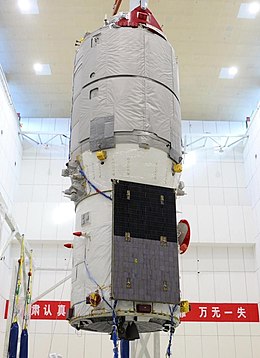


Tianzhou 2 cargo spacecraft prior to launch
| |
| Manufacturer | CASC |
|---|---|
| Country of origin | |
| Operator | CMSA |
| Applications | Tiangong Space Station resupply |
| Specifications | |
| Spacecraft type | Automated cargo spacecraft |
| Launch mass | 13,500 kg (29,800 lb) (basic); 14,000 kg (31,000 lb) (improved) |
| Payload capacity | 6,900 kg (15,200 lb) (basic); 7,400 kg (16,300 lb) (improved) |
| Dimensions | 10.6 m × 3.35 m (34.8 ft × 11.0 ft) |
| Volume | 40 m3 (1,400 cu ft)[1] |
| Production | |
| Status | Active |
| On order | 1 |
| Built | 8 |
| Launched | 7 |
| Operational | 1 |
| Maiden launch | Tianzhou 1 |
| Last launch | Tianzhou 7 |
| Related spacecraft | |
| Derived from | Tiangong-1 |
The Tianzhou (Chinese: 天舟; pinyin: Tiān Zhōu; lit. 'Heavenly Ship') is a Chinese automated cargo spacecraft developed from China's first prototype space station Tiangong-1 to resupply its modular space station. It was first launched (Tianzhou 1) on the Long March 7 rocket from Wenchang on April 20, 2017[2] and demonstrated autonomous propellant transfer (space refueling).[3][4]
The first version of Tianzhou has a mass of 13,500 kg and can carry 6,500 kg of cargo. Tianzhou-6 is the first improved version of the spacecraft to be launched into orbit; it has a mass of about 14,000 kg and can transport 7,400 kg of cargo.[5]

Based on the Tiangong-1 space station, the Tianzhou functions as the main automated cargo spacecraft for the Tiangong space station. It has pressurized, semi-pressurized and unpressurized cargo capabilities, and is able to transport airtight cargo, large extravehicular payloads and experiment platforms. It was first launched on the new Long March 7 rocket from Wenchang on April 20, 2017.[3][6]
The China Manned Space Engineering Office opened a consultation for the naming of the prospective cargo ship on April 25, 2011. By May 20, it had received more than 50,000 suggestions.[7] On July 8, Yang Liwei, China's first astronaut and deputy director of the Chinese Academy of Sciences revealed that they had a short list of ten names.[8] On October 31, 2013, it was revealed that the spacecraft had been named Tianzhou (Chinese: 天舟; pinyin: Tiān Zhōu; lit. 'Heavenly Boat'), combining the Chinese names of the Tiangong (Chinese: 天宫; pinyin: Tiān Gōng) space stations and the Shenzhou (Chinese: 神舟; pinyin: Shén Zhōu) spacecraft. They also stated that they would use the two letter identification TZ.[9]
| No. | Spacecraft | S/N | Launch (UTC) | Carrier Rocket |
Launch Pad |
Docking (UTC) | Deorbit (UTC) | Remarks | |||
|---|---|---|---|---|---|---|---|---|---|---|---|
| Station/ Port |
Docking | Undocking | |||||||||
| 1 | Tianzhou 1 | — | 11:41, April 20, 2017 (UTC) (2017-04-20T11:41Z) | Long March 7 | Wenchang LC-2 | Tiangong-2 Forward | 04:16, April 21, 2017 (UTC) (2017-04-21T04:16Z)[10] | 08:15, September 22, 2017 (UTC) (2017-09-22T08:15Z) | 10:00, September 22, 2017 (UTC) (2017-09-22T10:00Z) | Maiden flight of the Tianzhou spacecraft. First Tianzhou flight to Tiangong-2. | [10] |
| 2 | Tianzhou 2 | — | 12:55, May 29, 2021 (UTC) (2021-05-29T12:55Z)[11][12] | Long March 7 | Wenchang LC-2 | Tianhe Aft[a][11] | 21:01, May 29, 2021 (UTC) (2021-05-29T21:01Z)[11][12] | 07:59, March 27, 2022 (UTC) (2022-03-27T07:59Z) | 10:40, March 31, 2022 (UTC) (2022-03-31T10:40Z) | First Tianzhou flight to the Tiangong space station. | [13][14] |
| 3 | Tianzhou 3 | — | 07:10, September 20, 2021 (UTC) (2021-09-20T07:10Z)[15] | Long March 7 | Wenchang LC-2 | Tianhe Aft[b] | 14:08, September 20, 2021 (UTC) (2021-09-20T14:08Z)[16] | 02:59, July 17, 2022 (UTC) (2022-07-17T02:59Z) | 03:31, July 27, 2022 (UTC) (2022-07-27T03:31Z) | Second Tianzhou flight to the Tiangong space station. | [17] |
| 4 | Tianzhou 4 | — | 17:56, May 9, 2022 (UTC) (2022-05-09T17:56Z) | Long March 7 | Wenchang LC-2 | Tianhe Aft | 00:54, May 10, 2022 (UTC) (2022-05-10T00:54Z) | 06:55, November 9, 2022 (UTC) (2022-11-09T06:55Z) | 23:21, November 14, 2022 (UTC) (2022-11-14T23:21Z) | Third Tianzhou flight to the Tiangong space station. | [18] |
| 5 | Tianzhou 5 | — | 02:03, November 12, 2022 (UTC) (2022-11-12T02:03Z) | Long March 7 | Wenchang LC-2 | Tianhe Aft | 04:10, November 12, 2022 (UTC) (2022-11-12T04:10Z) | 08:46, September 11, 2023 (UTC) (2023-09-11T08:46Z) | 02:13, September 12, 2023 (UTC) (2023-09-12T02:13Z) | Fourth Tianzhou flight to the Tiangong space station. | [19] |
| 6 | Tianzhou 6 | — | 13:22, May 10, 2023 (UTC) (2023-05-10T13:22Z) | Long March 7 | Wenchang LC-2 | Tianhe Aft | 21:16, May 10, 2023 (UTC) (2023-05-10T21:16Z) | 08:02, January 12, 2024 (UTC) (2024-01-12T08:02Z) | 12:37, January 19, 2024 (UTC) (2024-01-19T12:37Z) | Fifth Tianzhou flight to the Tiangong space station. | [20] |
| 7 | Tianzhou 7 | — | 14:27, January 17, 2024 (UTC) (2024-01-17T14:27Z) | Long March 7 | Wenchang LC-2 | Tianhe Aft | 17:46, January 17, 2024 (UTC) (2024-01-17T17:46Z) | TBA | TBA | Sixth Tianzhou flight to the Tiangong space station. | [21] |
|
| |||||
|---|---|---|---|---|---|
| |||||
| Components |
| ||||
| Spaceflights |
| ||||
| Vehicles |
| ||||
| Sites and facilities |
| ||||
| Precursors |
| ||||
| |||||
|
| |||||||||||||||||||||
|---|---|---|---|---|---|---|---|---|---|---|---|---|---|---|---|---|---|---|---|---|---|
| |||||||||||||||||||||
| |||||||||||||||||||||
| |||||||||||||||||||||
| Navigation |
| ||||||||||||||||||||
| Telecommunications |
| ||||||||||||||||||||
Technology |
| ||||||||||||||||||||
| Related |
| ||||||||||||||||||||
| |||||||||||||||||||||
|
| |||||||
|---|---|---|---|---|---|---|---|
| General |
| ||||||
| Applications |
| ||||||
| Human spaceflight |
| ||||||
| Spacecraft |
| ||||||
| Destinations |
| ||||||
| Space launch |
| ||||||
| Ground segment |
| ||||||
| |||||||